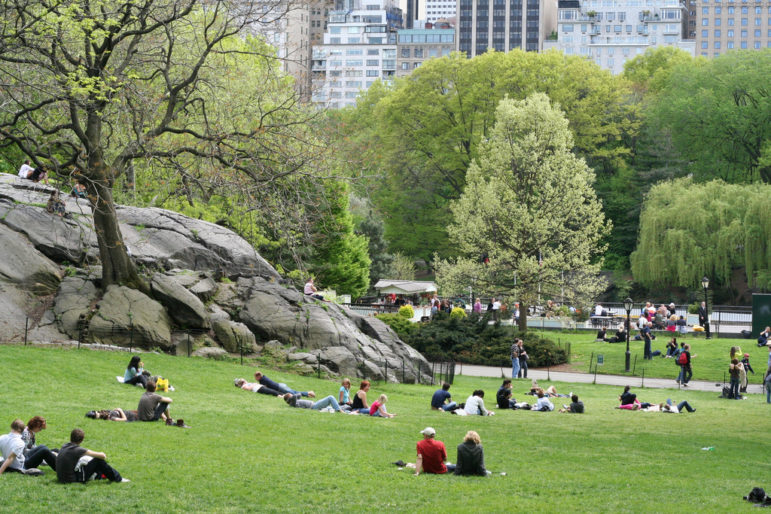
Dan Cipolla
‘If we look at parks not just from the point of view of their use and consumption, but also at their maintenance and as workplaces, the issues at stake in budget negotiations come into different focus. ‘
Parks are our green oases in concrete landscapes, places of respite from the hustle of the city, and sites of athletics and recreation. For the last nearly forty years, New York has been a national leader in thinking about how to preserve and expand this critical public space.
Yet, as with a good deal of urban infrastructure, it’s a lot sexier for politicians to cut ribbons on capital projects than it is to commit to their maintenance. Especially at times of budget uncertainty and diminishing federal aid, it is easier to let maintenance slide even if it will cost more later to replace poorly maintained equipment and landscaping.
If we look at parks not just from the point of view of their use and consumption, but also at their maintenance and as workplaces, the issues at stake in budget negotiations come into different focus. Take the current negotiation between the City Council and the mayor over whether to “baseline” or make permanent, fifty entry-level maintenance positions for which the Council has paid for the last two years. If we dig a little beneath the surface, we can see that the issue is a manifestation of a larger approach to governance. This approach has driven urban inequality, at least since the fiscal crisis of the 1970s. It is based on a combination of public disinvestment, privatization, and the use of unpaid and low-wage workers to maintain public goods, even while the value of these goods for the owners of private real estate has skyrocketed.
Since the late 1970s, in several waves, the city cut the number of full-time maintenance staff employed by the Parks Department by nearly half. How has the parks system survived? First, by privatizing the management of several parks to nonprofits, including, most famously, Central Park to the Central Park Conservancy. Although founders of the Central Park Conservancy blamed the condition of the park on a Parks Department whose managerial ranks had become a patronage mill, they decided to hire their own, private, maintenance staff and have since nearly completely replaced the city workforce in the Park. Several other conservancies have followed suit.
Hiring workers to replace unionized, public workers was done originally under false pretenses. The first workers at the Central Park Conservancy were called “interns” even when they were not. Conservancy staff are still paid less and have fewer rights and benefits than do regular parks workers. Similarly, first under Mayor Koch, and then under Mayor Giuliani, the City expanded the use of welfare recipients to clean parks. The program was widely hailed in the press. But workers in the Work Experience Program were not getting jobs: they were being set to work for their benefits at the equivalent of less than minimum wage, with no vacation days, no pension, and frequent exposure to racial and sexual harassment.
While Mayor de Blasio phased out the Work Experience Program, other welfare-to-work, job-training programs share some of the older, “workfare” program’s problems. The workers, mostly women coming off of welfare, are still temporary, and therefore still vulnerable, even though their pay has risen and is set to rise more.
A great deal of other free work gets done in the park. While parks managers will often say that volunteer work or the work done by people sentenced to community service is “extra,” the sheer number of work hours—over two million a year—suggests that these workforces are important for parks maintenance.
Few would dispute the value of volunteering or of alternative sentencing programs for nonviolent offenders. Yet, few also consider the way that, taken together, all of this free and low-wage labor has resulted in significant premiums in the value of real estate around the parks. While the public still enjoys a much nicer public good, the vast amount of money that goes to parks’ lucky neighbors is staggering. A 2007 study by Appleseed, Inc. showed that properties adjacent to Central Park enjoyed an 18 percent premium—totaling $17 billion—over other Manhattan real estate. Premiums for location next to well-maintained parks are even greater in percentage terms for other parks.
The story of parks workers is similar to the story of workers in most sectors of our economy. Seen in this light, the $9.6 million question of whether to make fewer than one worker per park district in the city permanent is an opportunity to take another step toward the progressive city that so many Council members and the mayor promote. Under the mayor, the Work Experience Program has been phased out, and the lowest-paid municipal workers, including Parks Opportunity Program workers, are scheduled to see their wages rise to $15 an hour. Though it seems a small step, making fifty positions permanent could be the start of another stride off the path leading from the fiscal crisis, and toward greater equality.
John Krinsky is professor of political science at the City College of New York, and Maud Simonet is a researcher at the National Center for Scientific Research (CNRS) in Paris. They are the authors of Who Cleans the Park? Public Work and Urban Governance (University of Chicago Press, 2017).








